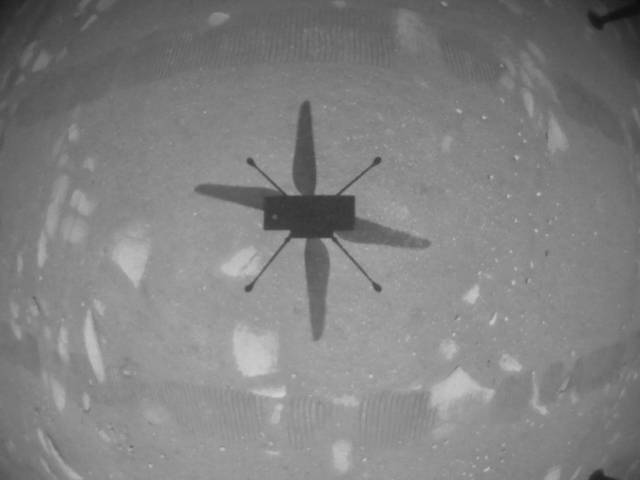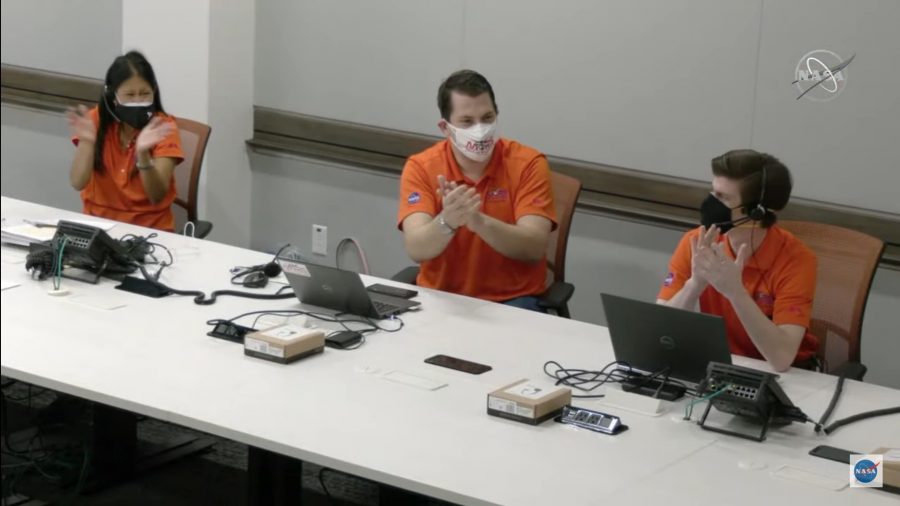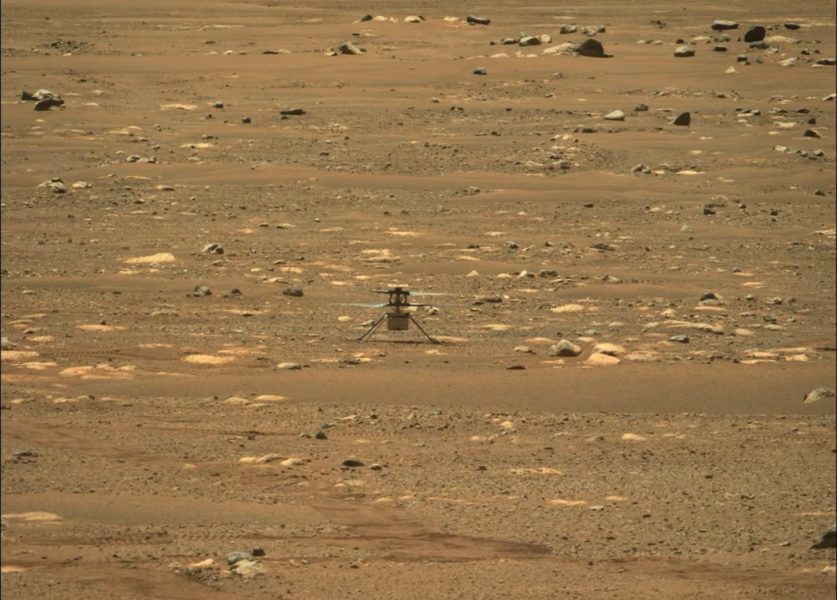NASA’s Ingenuity Mars Helicopter has made its brief hop into the history books of interplanetary aviation.
Updates:
On April 22nd, the Ingenuity Mars Helicopter made a second brief flight, climbing to 16 feet (only slightly higher than the 10 feet of the original feet). After hovering briefly, the helicopter made a slight, 5-degree tilt, enabling the rotors' thrust to carry the craft sideways by seven feet. More details can be found in NASA's press release.

NASA / JPL-Caltech
It may have been a short flight, but NASA’s Mars Ingenuity Helicopter performed a historic first early Monday morning, briefly taking to alien skies.
The flight occurred at 3:34 a.m. Eastern Daylight Time (7:34 Universal Time), and word of the flight reached Earth via the worldwide Deep Space Network at 6:46 a.m. EDT / 10:46 UT.

NASA TV
"Ingenuity is the latest in a long and storied tradition of NASA projects achieving a space exploration goal once thought impossible," said acting NASA Administrator Steve Jurczyk in a recent press release. "We don't know exactly where Ingenuity will lead us, but today's results indicate the sky — at least on Mars — may not be the limit."
The flight lasted just 39.1 seconds, as the solar-powered helicopter spun up its two four-foot-wide rotor blades, stacked in counter-rotating pairs, to more than 2,500 rpm. Ingenuity reached a height of 3 meters (10 feet) in a brief hover before safely landing back on the Martian surface. The black-and-white navavigation camera snapped several images during the hop, while the Perseverance rover documented the flight with its main Mastcam-Z and Navcam imagers from 64.3 meters (211 feet) away.
Today I witnessed history. Now you can too. You’re watching video of the #MarsHelicopter’s first flight – a true “Wright brothers” moment.
Watch it all unfold:
✅ Spin-up
✅ Takeoff
✅ Hover
✅ Turn
✅ LandingRead more: https://t.co/FIsf5RfHGj pic.twitter.com/hucsBY2RDE
— NASA's Perseverance Mars Rover (@NASAPersevere) April 19, 2021
Perseverance dropped off Ingenuity on April 3rd, then backed away to the Jakob van Zyl overlook site to give Ingenuity a clear airspace to carry out its first operations. The entire flight was autonomous, as Mars is currently 173 million miles (over 15 light-minutes) away.

NASA / JPL-Caltech / MSSS
Ingenuity was originally scheduled to fly on Wednesday, April 14th, but the helicopter’s "watchdog timer" shut down early during a high-speed spin-up test the weekend prior. Engineers re-assessed and uploaded new commands to the helicopter this past weekend. A successful spin-up test prior to today’s flight was completed on April 17th.
The "airfield" that Ingenuity sortied from was named Wright Brothers Field today, in honor of the first powered flight in 1903 at Kitty Hawk, North Carolina. (That historic event was also brief, lasting only 12 seconds.) Ingenuity carries a postage stamp-sized swatch of the original Wright Brothers flyer to commemorate the occasion. Wright Brothers Field even received the International Civil Aviation Organization (ICAO) airport code "JZRO" for today’s flight, with Ingenuity receiving the flight call sign "IGY-1."
Ingenuity saw its own shadow during the brief flight, as Perseverance captured a series of images which were posted by NASA on the rover’s Twitter feed early on Monday.
"We have been thinking for so long about having our 'Wright brothers moment' on Mars, and here it is," said project manager MiMi Aung (NASA-JPL) in a recent press release. "We will take a moment to celebrate our success, and then take a cue from Orville and Wilbur regarding what to do next. History shows they got back to work to learn as much as they could about their new aircraft — and so will we."
Ingenuity was designed by NASA/JPL, and cost $85 million from design through operation. The mission is a challenging one, as the Martian atmosphere is only 1% that of Earth’s at sea level. Standing just 19.3 inches (49 centimeters) high and with a mass of 1.8 kilograms, much of the miniaturized tech aboard Ingenuity owes its existence to modern smartphone technology. Though Ingenuity carries no science instruments, it does have a laser altimeter and two cameras onboard. The main 13-megapixel color camera faces the horizon to image the terrain, and one 0.5-megapixel black and white camera faces downward for navigation.
Though it represents a proof of concept, powered flight is expected to become standard during future missions. A flying mission can scout the terrain ahead or reach areas inaccessible via wheels on the ground. NASA’s next interplanetary rotorcraft, the nuclear-powered Dragonfly mission, is scheduled to head to Saturn’s largest moon Titan around 2027.
The Ingenuity team has two weeks left in its 30-day window for operations, during which the helicopter may complete up to four more flights. Watch for the next one to occur not earlier than April 22nd. Flight 2 will see Ingenuity reaching an altitude of 5 meters, then flying laterally for 2 meters. On Flight 3, Ingenuity will fly to an altitude of 5 meters before attempting a 50-meter out and back horizontal flight.

NASA / JPL-Caltech / MSSS
After that, Perseverance will move on with its packed primary science mission. After April, Ingenuity will come to rest one last time on the surface of Mars in Jezero Crater, a small testament to the first flight on the Red Planet.
 0
0









Comments
You must be logged in to post a comment.